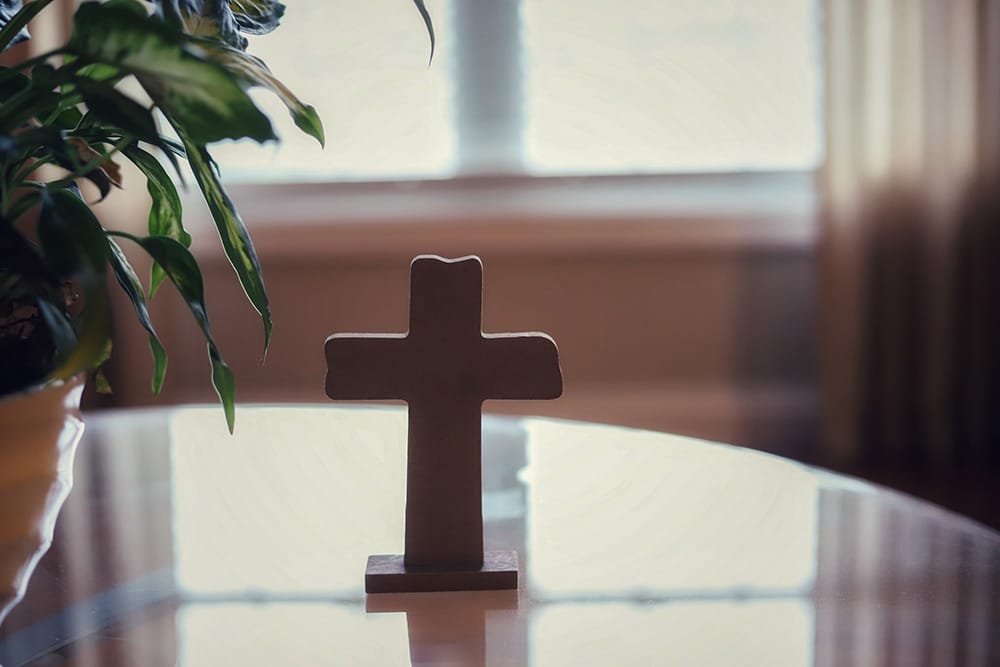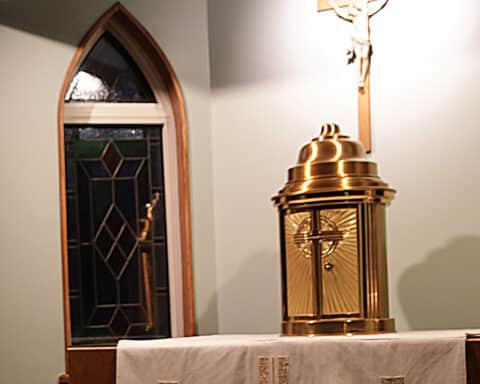American Catholics are facing an unimaginable Holy Week this year. With the suspension of public Masses throughout every diocese in all 50 states, there will be no Palm Sundays in our parishes, no Triduum liturgies, no joyous Easter Sunday Mass. It’s almost unthinkable — yet here we are.
| Livestreaming |
|---|
| With your Spirit is an online database of Mass streams. |
Nothing can ever replace the solemnity and beauty of Holy Week in our churches, and so the absence of public worship during these holiest days of the year presents a moment of pause and pain. The void created in our spiritual lives by our lack of access to the sacraments can be seen to draw us closer to Christ’s own solitude in his final agony and suffering. And yet, we cannot remain there. By our Easter faith, we know that Christ is alive and among us. “I am with you always,” he promised (Mt 28:20). As the late Cardinal Francis E. George, O.M.I., reiterated: “The Risen Lord will never abandon his people. Those who find their personal identity in relation to him will never be alone.” Knowing all things work for the good, let us not dwell in our sadness, but as Easter people, fervently pray for the grace given to Mary Magdalene on the first Easter morning: for the eyes to see the Risen Lord in our midst and the ears to recognize his voice as he speaks to us.
So while we are unable to celebrate Holy Week in our churches, here are some ways we might bring these holiest days of the year into being in our homes.
Read: Vatican releases pope’s pandemic-influenced plan for Holy week, Easter
SPIRITUAL TREASURES
Thankfully, as Catholics, we have a wealth of prayer and spiritual resources to which to turn. Though unable to gather in community at parishes and shrines across the country, we are able to gather at home — what the Church has long taught is properly understood as “the domestic church.” And while we would much rather attend Holy Week’s sacred liturgies, we know that Jesus will be with us, because he told us so: “And behold, I am with you always, until the end of the age” (Mt 28:20).
Buy now on Kindle: Catholic Prayers for All Occasions
Liturgy of the Hours
In recent decades, a growing number of laypeople have taken up praying the Liturgy of the Hours, the Church’s most important prayer outside of the Mass. It might be difficult to obtain a copy of the official texts on short notice, however, there are a variety of resources available online and through mobile apps. While morning prayer and evening prayer are among the most popular, the Office of Readings might be fitting during these days as well, especially concerning the vigil for Easter. If you are unfamiliar with how the Liturgy of the Hours works, there are also plenty of resources online to help you begin navigating this spiritual treasure.
Read: Sunday morning prayer from the Liturgy of the Hours
The Rosary
Holy Week draws us to contemplate more deeply the Lord’s passion and death. One of the greatest forms of contemplative prayer available to the faithful is the Rosary, the sorrowful mysteries of which give us a fitting place to begin our meditations. In his 2003 apostolic letter on the Rosary, Rosarium Virginis Mariae, Pope St. John Paul II said, “The sorrowful mysteries help the believer to relive the death of Jesus, to stand at the foot of the Cross beside Mary, to enter with her into the depths of God’s love for man and to experience all its life-giving power” (No. 22). These days certainly present a need for that kind of prayer. If families are unfamiliar with praying the Rosary together, one option could be to pray a decade each of the days during Holy Week.
Stations of the Cross
Venerable Archbishop Fulton J. Sheen wrote: “The great tragedy of the world is not what people suffer, but how much they miss when they suffer. Nothing is quite as depressing as wasted pain, agony without an ultimate meaning or purpose.” The Stations of the Cross make tangible every imaginable aspect of human suffering, all of which were on full display in the events of Christ’s passion. And the Stations teach us to see the suffering’s purpose, especially in a time when so much of it surrounds us.
Read: Walking the Stations of the Cross this Lent
A variety of online resources are available for meditations on the Stations of the Cross. (A virtual tour of the Shrine of Christ’s Passion in St. John, Indiana, for example, can be a helpful tool.) They do not need to be long or complicated. We could travel around a room, house or outdoor lawn to take some part in Christ’s journey to Calvary. Perhaps simple crosses could be distributed in different places within such venues or even printouts of images related to each station.
Read: Doing the Stations of the Cross with your kids (including tips on doing this from home!)
Buy now on Kindle: The Way of the Cross for the Holy Souls in Purgatory
Buy now on Kindle: Every Step with Jesus: Following the Saints in the Way of the Cross
Praying with Scripture
Spend time with Scripture this Holy Week. Take a passion narrative from one of the four Gospels and read a bit each day. Take the readings from the Lectionary presented for use at the liturgies of Holy Week and spend time meditating upon them. The Easter Vigil’s seven Old Testament readings could be used each day of Holy Week leading up to Easter as an opportunity to walk through salvation history.
Livestreaming
One of the blessings of our technological age is that many bishops and parish priests have been livestreaming their daily or Sunday Masses, including Pope Francis. While the faithful are not able to be present at the liturgies of Holy Week — liturgies that undoubtedly will be slightly different than usual — such livestreams are a good reminder that the Church is still publicly at prayer and that God is still being worshipped. All the baptized share in the spiritual fruits and graces of each and every Mass and can unite their sacrifices to the sacrifice of Christ, even if remotely. That’s because each Mass is an act of worship on behalf of the whole Church — the Body of Christ, of which each of us becomes members at our baptism. Above all, it’s most important to remember our unity with the Lord and how that can be strengthened by a spiritual communion. Through such a simple prayer, we can receive all fruits of the sacrament even during times as dire as we are presented with today.
Read: Your guide to Holy Week: Customs, quiz, 12 ways to make it more meaningful
LITURGICAL LIFE AT HOME
In our homes — our domestic churches where the Faith is lived out mostly from day to day — we can connect ourselves more closely to the Church’s liturgical life. This can be done even in simple ways, particularly by setting aside a special place to pray. One common practice in homes is to have a domestic prayer altar with a simple cloth, a crucifix or other sacred images, or a candle. Other items can be kept there as well, such as rosaries, the Bible or holy water. Other decorations related more directly to the day being celebrated are recommended as well. If colors of decor can be changed, use white on Holy Thursday and Easter, red on Palm Sunday and Good Friday, and purple in between.
Read: A parent’s guide to Lent and Holy Week
A set place for common prayer in the home would be a great idea to help foster your family’s prayer life, especially during the sacred days of Holy Week. You might invite friends and relatives to join you digitally in prayer.
Each of the days in Holy Week has its own character and traditions, some elements of which easily can be implemented at home.
Read: Walking through Holy Week as a family
Read: Holy Week ideas and conversation starters for families
Palm Sunday
In commemoration of the Lord’s triumphal entry into Jerusalem, branches from the yard could be carried in procession throughout your yard or nearby outdoor space. It doesn’t need to be elaborate. (For those with access to palm branches, here’s a free PDF download on how to make those lovely palm crosses.) Take time to read Matthew 21:1-11, as might be done at the start of Mass. You can sing or play a hymn praising Christ our Lord and King along the way, such as the traditional “All Glory, Laud and Honor.” No need to be quiet about it; when Jesus was told to silence the crowds on the first Palm Sunday, he replied, “I tell you, if they keep silent, the stones will cry out!” (Lk 19:40). End your procession at a home altar, where you can reflect upon the passion narrative (Mt 26:14–27:66) or livestream a Mass.
Listen: Music playlists for Holy Thursday, Good Friday and Easter
Holy Thursday
At the Last Supper, Jesus washed his apostles’ feet, an act of sacrificial love and service by which he gave meaning to what he would accomplish on the cross the next day. Washing one another’s feet would be a great way for loved ones to recall the Lord’s Holy Thursday mandate to love one another as he has loved us. Begin by reading the evening’s Gospel passage (Jn 13:1-15) and conclude with a simple meal.
In commemoration of the Lord’s agony in the garden, it is customary to spend the night in Eucharistic adoration. While attending adoration at a church likely isn’t an option for Catholics this year, there are livestreams of Eucharistic adoration available online. The time adoring Christ, even through the screen, can be spent in quiet meditation, reflection on relevant Gospel passages, recitation of the Rosary or making an act of spiritual communion.
Read: Holy Thursday history and traditions
Good Friday
The last several weeks have felt something like Good Friday, a day on which Mass is not celebrated, along with several other sacraments. For the veneration of the cross that takes place at this liturgy, we should choose a crucifix at home by which to honor Christ’s passion and death. Gather together and read the passion narrative from the day (Jn 18:1–19:42), keeping the crucifix as a focal point in the room. It would be good for each person to venerate it with a genuflection or a kiss, according to custom. We say, “Behold the wood of the Cross, on which hung the salvation of the world. Come let us adore.”
Good Friday is one of two annual obligatory days of fasting for Catholics. With life so jarringly altered, perhaps our fasting will take on new meaning this year, and perhaps we can increase our fasting for the good of all those suffering and caring for the sick throughout the world. Fasting certainly creates a void within us, so that we may recognize our dependence on God above all else. But it can also be an opportunity to open us up to the needs of others, particularly those who need our prayers during these days.
Easter
Even though we may not be together as a community to celebrate Easter, the Lord is risen! Let us rejoice, therefore, and be glad!
As you begin your Easter celebration, take time to read one of the Gospel accounts of when the tomb was found empty (there are several options). This is the center point of human history and should take on that significance in our lives. Be sure, also, to watch Mass on TV or online, if possible.
Because we can worship in all that we do, we celebrate Easter with all we have. Many traditional foods are associated with Easter from cultures around the world. Perhaps do some research and try to make a special paschal cuisine. Easter eggs, be they dyed or plastic, can be hidden in the yard or the house, and they remind us of the endless possibilities that flow from Christ’s triumph over the grave.
Another special Easter practice is to adorn the cross (you could use the same one as used on Good Friday) with spring flowers, a visible reminder that God has transformed the meaning of even suffering and death. If flowers are hard to come by at home, another possibility is to encourage children to draw, color or paint such decorations. Perhaps large “Alleluia!” posters can be made to add a bit of Easter festivity to the home. Easter songs are not as well-known and popular as Christmas carols, but don’t let that stop you from letting your alleluias ring out, for Christ is truly risen from the tomb. No matter the difficulty of crisis, Easter reminds us that God always wins — indeed, he’s already won, and so no matter the sorrow around us, we can be filled with joy.
Michael R. Heinlein is editor of Simply Catholic. He writes from Indiana.





